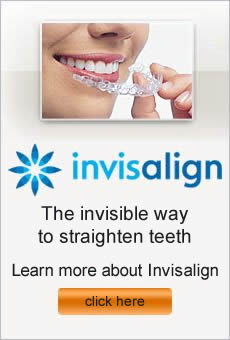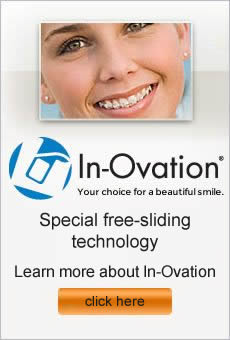Placing the Braces
Before placing braces, we will remove debris from the teeth and prepare the surfaces so the brackets can be applied using fluoride-releasing glue. The fluoride in the glue wards off cavity-causing bacteria in the areas where the brackets sit over the teeth. We protect your teeth right from the beginning! Once we place the brackets, the wires that move the teeth are put into the bracket slots. As soon as the wires are engaged, your teeth will begin to move, but you won’t feel the movement at this point.
How Braces Feel
During the placement appointment, patients usually notice the brackets touching their cheeks and tongue. It will take some time to adjust to having braces. A few hours after the appointment, your teeth will start feeling the movement of the braces. The best way to describe this sensation is to think about when you exercise and your muscles feel sore the next day. The soreness in your teeth may last several days. Because each person’s perception of the discomfort is different, this experience is unique to each patient. Dr. Fotovat and his team will do everything they can to make this as painless as possible.
You will need time to get used to this feeling as the braces begin moving your teeth. If you take Tylenol or Advil for a headache, these medicines may reduce the soreness. We will also provide dental wax to use if you experience rubbing on your cheeks or tongue.
Loosening of Teeth
Soon after the braces are put on, your teeth will begin shifting. In a few days, you may notice some of the teeth feel loose. Don’t be alarmed! This is the normal and is how teeth move through the bone. In addition to feeling teeth loosen, patients may see openings where there were none before. As your teeth shift into the optimal position, the extra spaces will close, and your teeth will firm up again. Dr. Fotovat and his team will make sure your Picture Perfect Smile is exactly that!
Caring for Braces
When we place your braces, we will also review care instructions. Achieving a successful outcome depends on how well you care for your teeth, treat the brackets, and follow our recommendations. Patients who actively participate in their treatment get better results faster.
- Brushing
While wearing braces, patients need to keep the teeth, gums, and brackets clean. We will provide you with a complimentary orthodontic hygiene kit. Our team will also review best dental hygiene practices and show you how to use each item in our kit so you have the proper tools for success.Use a soft bristle toothbrush after every meal and before bed. Place the toothbrush at a 45-degree angle, brushing above, below, and in between the brackets. Don’t forget to brush your tongue and the roof of your mouth. Afterwards, make sure no food or plaque remains on or around the teeth. Replace your toothbrush every three to four months, or at the first sign of fraying. Consider an electric toothbrush; they reduce plaque better than manual toothbrushes. If you have any questions about brushing, please don’t hesitate to ask someone on our team!
- Flossing
Flossing removes the plaque and food caught in between teeth and braces, so you need to floss at least once a day, preferably before bed. The complimentary hygiene kit we provide will contain floss and reusable floss threaders, which will help you slip the floss under the wires. Don’t worry, we will show you how to floss with braces! Flossing while wearing braces make take a little getting used to, but it is a crucial part of maintaining overall dental health. Good oral hygiene reduces gum disease and tooth decay. Healthy teeth move more efficiently and your treatment will progress more effectively. Electric flossers are also an option to make flossing easier.
- Rinse
Mouth rinses like Listerine Total Care will help minimize plaque build-up, kill bacteria, and reduce irritations and minor gum inflammation.
Eating with Braces
Food particles and plaque accumulate naturally on teeth with or without braces, but the brackets make it easier for food residue to sit on the surface of your teeth. This food and plaque create a higher acidity level, which can lead to cavities or gum irritations. To reduce the chance of damaging the brackets and decrease the risks of cavities or gum irritations, we ask our patients to avoid certain foods during orthodontic treatment.
Making smart food choices will help reduce the amount of plaque build-up on and around your teeth. Foods with higher sugar content produce more plaque. Sticky and chewy foods tend to stick to the brackets and/or teeth creating more plaque. Sodas cause issues due to their high sugar content. The carbonation in soda can also break down the glue on the brackets. To keep brackets from breaking, cut hard-to-chew foods into small, bite-size pieces. Cavities, broken brackets, and swollen gums can prolong your treatment time and hurt your overall dental health.
The following list identifies foods to avoid, but use common sense and logic before eating foods that can potentially damage your braces. Bent wires affect the movement of your teeth and should be reported to Dr. Fotovat right away. If you have any questions about foods to avoid, ask a member of the Fotovat team!
Foods to Avoid:
- Chewy foods like licorice, Skittles, and gummy bears
- Crunchy foods such as popcorn, ice, thick chips, and pretzels
- Sticky foods including gum, caramels, taffy, and dried fruit
- Hard foods like nuts, candy, and firm bread
- Biting on hard substances like pencils, pens, or nails
- Food with bones like chicken wings and ribs*Cut these foods into small pieces: crusted breads, corn on the cob, pizza crust, raw carrots and apples, firm meats, etc.
For More Information
Many helpful and informative videos on these topics and others are available in our Orthodontics Video Library. Please always feel free to call the office at (818) 980-5300 with any questions or concerns.



